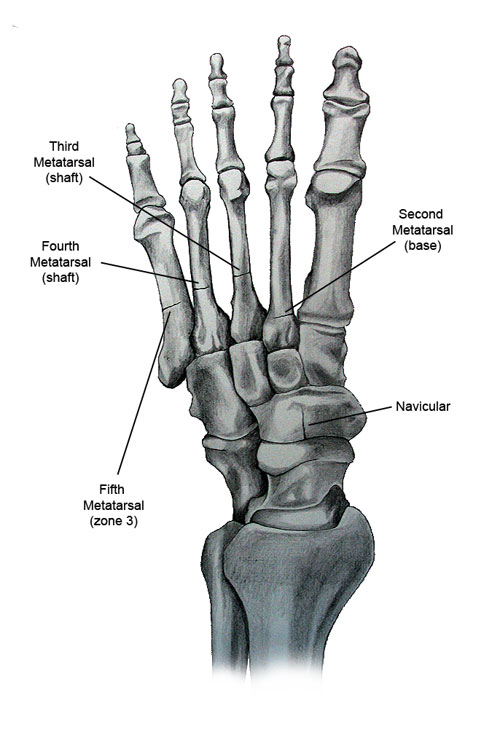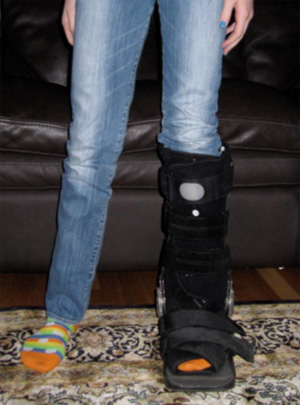Stress Fracture Heals Big Toe Then Hurts Again
- What is a stress fracture?
- Causes of a stress fracture in the foot and talocrural joint
- What bones in the human foot and ankle are affected by a stress fracture?
- What are the symptoms of a stress fracture in the foot and ankle?
- How are stress fractures diagnosed?
- How do you treat a stress fracture?
- How long does it take for a stress fracture to heal?
- Volition I need surgery?
- Preventing stress fractures
What is a stress fracture?
A stress fracture is a type of bone interruption or cleft in the bone. Stress fractures occur when a modest or moderate corporeality of force is practical to a bone repeatedly and over time. This is unlike from a traumatic fracture, in which a significant amount of strength is practical suddenly, such as in the example of a severe ankle twisting injury, which can cause acute ankle fractures, or in a car collision, when bones in the foot may be broken or crushed).
Stress fractures are common in foot and ankle bones because we continually place force on them by standing, walking, running and jumping. In a stress fracture, the bone breaks only normally does not shift position (become "displaced").
The forces that cause a stress fracture in the pes or talocrural joint are like to those when you curve a paper prune. If y'all gently curve a paper clip once, it will not intermission. Just if y'all continue to curve it back and forth multiple times, the metal becomes weakened (or "fatigued") and eventually breaks. Bones that are subjected to repetitive force can experience a like blazon of fatigue called a "stress reaction." This increases the run a risk that the bone will eventually intermission, that is, endure a stress fracture.
Causes of a stress fracture in the human foot and talocrural joint
Stress fractures more often than not occur by one of two means:
- People with salubrious bones overuse the foot and talocrural joint by frequent, repetitive movement. This is specially the case in athletes who participate in loftier-affect sports such as running track and field, football, basketball, soccer, tennis, gymnastics or cheerleading.
- People who have very weak bones from a separate, underlying status (such as osteoporosis) sustain a stress fracture in the foot even from fairly low-bear upon activities such as frequent walking. This type of stress fracture is called an "insufficiency fracture" because information technology happens in a bone that does non have "sufficient" density or strength to withstand normal impact forces. Insufficiency fractures can sometimes bear on younger, otherwise healthy women who exercise excessively, because such activity can pb to irregular or absent-minded menstrual cycles, which in plow affects the strength of their basic.
The pes and ankle are the most common parts of the body to experience a stress fracture because we are constantly on our anxiety. Foot and ankle stress fractures oft occur in people who begin a new action that involves any impact of the feet on the ground, such as hiking or running. Stress fractures besides occur in people who quickly increase the amount of a certain kind of activity. For example, somebody who normally runs twice a week for 30 minutes who then suddenly begins to run vii days a week for ane hour has an increased take chances of getting a stress fracture.
Shoes that provide poor support, such as loftier heels – which place a lot of pressure on the toes – as well every bit old, stiff shoes tin put a person at chance. Finally, people with pes deformities that change their load bearing can develop stress fractures. For example, in a foot with a bunion, the big toe may be repositioned such that stops supporting the weight information technology should normally should acquit. This places more load force on the other toes, which tin lead to a stress fracture in one or more than of them. In such cases, the second toe (next to the big toe) is the about probable to fracture.
What bones in the foot and ankle are affected by a stress fracture?
Any of the basic of the lower leg, ankle and foot tin can experience a stress fracture. The most commonly affected bones are:
- The metatarsals, which connect the toes to the midfoot.
- The calcaneus (heel bone).
- The navicular, a bone near the ankle. Navicular stress fractures take a long time to heal.
- The bones that make up the ankle articulation – particularly the tibia and fibula.

Anatomical drawing of the pes, showing the metatarsal and navicular bones. (Illustration past Joseph Yu, BS.)
What are the symptoms of a stress fracture in the human foot and ankle?
The primal symptom of a stress fracture is pain. Depending on the bone affected, it tends to hurt in very specific, pinpoint areas, and it will hurt when you bear upon the exact area where the bone is broken.
If you have recently changed or increased your activity and take pain in a specific area of the foot or ankle, you may have a stress fracture. The hurting commonly becomes more than intense when you practise affect activities and gets ameliorate during periods of residue.
If you recall you may have a stress fracture in your human foot or ankle, the well-nigh important matter to do is to immediately stop all activities that crusade hurting. If an untreated stress fracture worsens (gets bigger), y'all will get-go feeling the pain more quickly during activity that puts stress on the affected bones than when the stress fracture first appeared.
If your pain continues after several days of balance or if your pain goes away but and then returns fifty-fifty after several weeks of rest, y'all should run into an orthopedic foot and talocrural joint surgeon (as well called an "orthopedist" or "orthopaedist").
How are stress fractures diagnosed?
Your physician will kickoff enquire you questions about your pain and level of activity to evaluate you for the take a chance factors discussed to a higher place.
Next, he or she will examine you and society X-rays for the area where you experience pain. When a stress fracture is nowadays, it is actually not uncommon for the X-rays to appear normal and show no suspension in the bone. This is because sometimes the bone reacts and grows new os to heal the crack. (However, the injured os is notwithstanding vulnerable to being rebroken.) When new os grows, the final step is for it to calcify. A radiologist or orthopedist ofttimes confirms the stress fracture diagnosis by seeing the calcification of new bone growth on your X-ray.
In certain cases your physician may order a bone scan or MRI to provide more than information than does a standard X-ray. However, these more than expensive tests are not routinely needed to diagnose a stress fracture.
How do you lot treat a stress fracture?
About stress fractures volition heal on their own if you reduce your level of activity and article of clothing protective footwear for a catamenia of time. Equally mentioned above, the most important thing to do if yous accept or think you may have a stress fracture in your foot or ankle, is to terminate the activity that caused your problem in the first place. You should end all loftier-impact action for a time, typically for about six weeks.
Icing and elevating the affected leg immediately following a stress fracture tin can assist decrease swelling and pain. Every bit for hurting, information technology is best to take acetaminophen (Tylenol) instead of nonsteroidal anti-inflammatory drugs (NSAIDs), which includes ibuprofen (Advil) and naproxen (Aleve). This is because some information suggests that taking NSAIDs tin can reduce the ability of bone to heal.
Your orthopedist may recommend that y'all wear a stiff-soled shoe, a wooden-soled sandal, or a removable "walking boot," too known as a brusque leg-fracture brace shoe.

A typical fracture brace or "walking boot" worn to let a nondisplaced fracture to heal.
How long does it take for a stress fracture to heal?
Many stress fractures of the foot or talocrural joint volition heel in 4 to 6 weeks. However, healing times vary, depending on which bone is cleaved. Some human foot bones, such as the navicular or the fifth metatarsal, can have a much longer time to heal than do others.
Subsequently weeks of rest, and once the pain is completely gone, yous may gradually ease back into concrete activity and sports. This gradual reintroduction period should span about 4 to six weeks. Switch to a sport that puts less stress on the foot and leg until you accept fully recovered. Examples of appropriate low-impact activity include:
- Swimming
- Cycling (bicycle riding or spin classes)
The worst choices for resumed activeness while you lot recover from a human foot or ankle stress fracture are running or even walking on hard surfaces. You can hands reopen your fracture and accept to begin the recovery process again.
During recovery, vesture comfortable, supportive shoes without a raised heel. Footwear should exist flexible, not potent. If you are a runner, later on y'all have resumed low-impact action for iv to half dozen weeks, begin a conservative jogging regimen. Increment your running mileage very slowly over time. Practise non practice besides much, as well soon.
Will I demand surgery?
Surgery is rarely needed and is recommended normally but afterwards conservative, nonsurgical approaches above are not working.
Preventing stress fractures
The following principles can help you lead a healthy lifestyle and avert issues with stress fractures:
- Consume calcium-rich foods and ensure you get plenty daily Vitamin D to help maintain os density.
- Article of clothing good shoes. Do not wear old or stiff shoes, but instead effort comfortable, well-padded, and supportive shoes. It is usually a skillful idea to wear shoes fabricated specifically for the sport y'all would similar to do. Avoid high heels whenever possible.
- Do not smoke. This can lead to problems with healing. Information technology is actually the nicotine that creates the trouble, and so other gum and products containing nicotine will withal forestall the os from healing.
- Cross-railroad train. This ways that you should alternate between activities. For example, yous can switch upward jogging with swimming or cycling during the calendar week.
- Slowly ease into previous or new sports activities. Gradually increase the time, speed, and altitude. Many experts suggest a 10% increment of exercise time per week.
Updated: v/31/2019
Authors
Related articles
Source: https://www.hss.edu/conditions_stress-fractures-foot-ankle.asp

0 Response to "Stress Fracture Heals Big Toe Then Hurts Again"
Post a Comment